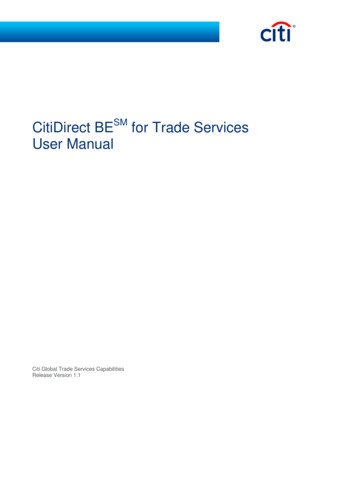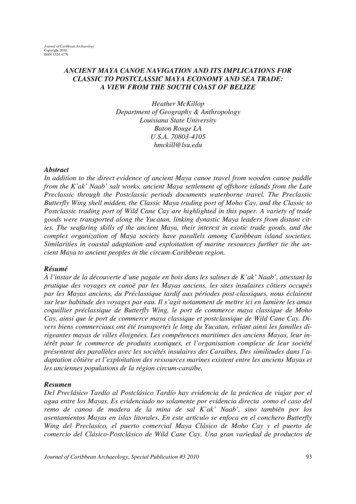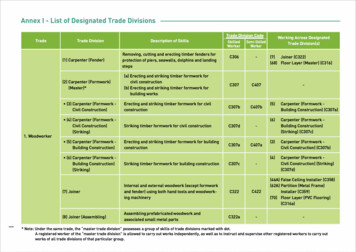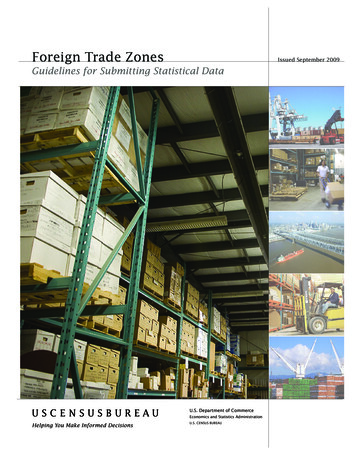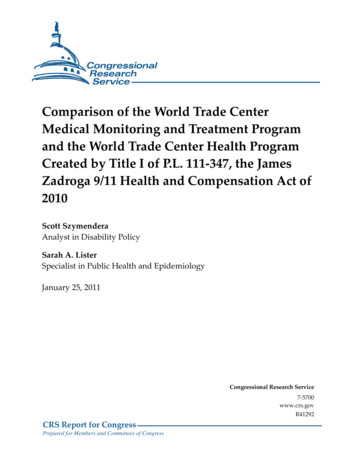
Transcription
Comparison of the World Trade CenterMedical Monitoring and Treatment Programand the World Trade Center Health ProgramCreated by Title I of P.L. 111-347, the JamesZadroga 9/11 Health and Compensation Act of2010Scott SzymenderaAnalyst in Disability PolicySarah A. ListerSpecialist in Public Health and EpidemiologyJanuary 25, 2011Congressional Research Service7-5700www.crs.govR41292CRS Report for CongressPrepared for Members and Committees of Congress
Comparison of the WTC MMTP and the WTCHP Created by P.L. 111-347SummaryIn the wake of the September 11, 2001, terrorist attacks, Congress passed appropriations toprovide limited health screening and treatment services to persons involved in rescue, recovery,and cleanup operations around the former site of the World Trade Center. This program, nowknown as the World Trade Center (WTC) Medical Monitoring and Treatment Program (MMTP),is not authorized in statute but rather relies on discretionary appropriations to provide services toeligible individuals. Since its inception in FY2002, the MMTP has received approximately 475million in federal funds, and over 57,000 responders and community members have met initialeligibility requirements for the program.On January 2, 2011, President Barack Obama signed into law P.L. 111-347, the James Zadroga9/11 Health and Compensation Act of 2010. Title I of P.L. 111-347 replaces the MMTP with aprogram authorized in statute and financed through mandatory federal spending, partiallymatched by New York City. This program, called the World Trade Center Health Program(WTCHP), will provide full medical screening and treatment benefits to eligible WTC respondersand community members beginning in July 2011. In addition, Title I of P.L. 111-347 establishesformal eligibility requirements based on a person’s activities after September 11, 2001, and his orher current health conditions. Health benefits will be provided by Clinical Centers of Excellence,a national network of providers, and the program will be administered by the Department ofHealth and Human Services (HHS).The WTCHP will sunset at the end of FY2016 or FY2015 if a federal spending cap is met. Totalfederal spending on the program is capped at 1.556 billion over the life of the program. NewYork City will contribute 10% of the program’s costs through FY2015, after which itscontribution would become equal to one-ninth of any federal spending in FY2016. In addition topersons already receiving services under the MMTP, the WTCHP will serve up to 25,000 newresponders and 25,000 new community members, referred to as survivors.Congressional Research Service
Comparison of the WTC MMTP and the WTCHP Created by P.L. 111-347ContentsBrief Descriptions of Programs .1World Trade Center Medical Monitoring and Treatment Program .1World Trade Center Health Program.2Comparison of Program Elements .2Authority .2MMTP.2WTCHP. 3Financing.3MMTP.3WTCHP. 3Eligibility for Benefits.4MMTP.4WTCHP. 4Covered Conditions .7MMTP.7WTCHP. 8Benefits .9MMTP.9WTCHP. 9Provision of Medical Services . 10MMTP. 10WTCHP. 10Oversight . 10MMTP. 10WTCHP. 11TablesTable 1. Responders and Community Members Meeting Initial Eligibility Requirementsof the WTC Medical Monitoring and Treatment Program (MMTP) .2Table 2. Covered Conditions Under the MMTP and WTCHP .8Table A-1. Funding for the WTC Medical Monitoring and Treatment Program . 12Table A-2. Maximum Federal Contributions to the WTC Health Fund . 12AppendixesAppendix. Funding Data for the WTC Medical Monitoring and Treatment Program andthe WTC Health Fund . 12ContactsAuthor Contact Information . 12Congressional Research Service
Comparison of the WTC MMTP and the WTCHP Created by P.L. 111-347Brief Descriptions of ProgramsThis report compares the current federally supported medical screening and treatment programoffered to various persons affected by the terrorist attacks of September 11, 2001, with the federalprogram established by Title I of P.L. 111-347, the James Zadroga 9/11 Health and CompensationAct of 2010. The following specific programs are compared in this report: The World Trade Center (WTC) Medical Monitoring and Treatment Program(MMTP), financed through discretionary appropriations to the Centers forDisease Control and Prevention (CDC), National Institute for OccupationalSafety and Health (NIOSH);1 and The World Trade Center Health Program (WTCHP) established by Title I of P.L.111-347.Related programs such as the World Trade Center Health Registry, administered by the CDCAgency for Toxic Substances and Disease Registry (ATSDR), and the September 11th VictimCompensation Fund of 2001, are not discussed in this report.2World Trade Center Medical Monitoring and Treatment ProgramFollowing the September 11, 2001, terrorist attacks, Congress provided appropriations to furnishhealth care services for rescue, recovery, and cleanup workers and others, in what is now calledthe World Trade Center Medical Monitoring and Treatment Program (MMTP).3 The MMTP is notexplicitly authorized, but has received discretionary appropriations to pay for medical monitoringand health care services for eligible individuals. The MMTP funds medical screening, monitoring,and treatment services for eligible paid workers and volunteers who were involved in the rescue,recovery, and cleanup activities following the attack (referred to as “responders”), and morelimited services for some residents and others in the vicinity of the WTC during and after theattack (referred to as “community members”). Services are provided through a limited network ofproviders.As shown in Table 1, through the end of FY2010, a total of 52,978 responders and 4,936community members applied for and met the initial eligibility requirements for the MMTP.1See CDC, NIOSH, “World Trade Center Health Programs,” http://www.cdc.gov/niosh/topics/wtc/.Additional information on the World Trade Center Health Registry can be found at .shtml. Additional information on the September 11th Victim Compensation Fund of 2001 can be foundin CRS Report RL33927, Selected Federal Compensation Programs for Physical Injury or Death, coordinated bySarah A. Lister and C. Stephen Redhead.3The MMTP is one of a number of federal, state, and local programs that have funded or provided certain health careservices to various groups affected by the WTC disaster. Information about some other programs may be found inGAO, September 11: Problems Remain in Planning for and Providing Health Screening and Monitoring Services forResponders, GAO-07-1253T, September 20, 2007, p. 7 ff.2Congressional Research Service1
Comparison of the WTC MMTP and the WTCHP Created by P.L. 111-347Table 1. Responders and Community Members Meeting Initial EligibilityRequirements of the WTC Medical Monitoring and Treatment Program (MMTP)(as of September 30, 2010)CategoryMet Initial Eligibility RequirementsFire Department (FDNY) responders15,721Responders living in New York City (NYC) area33,578Responders living outside of NYC areaTotal all respondersCommunity membersTotal3,67952,9784,93657,914Source: Centers for Disease Control and Prevention, National Institute for Occupational Safety and Health,“Number of Participants in the WTC Health Programs,” tml.Note: Includes all persons who have met the initial eligibility requirements of the program, whether or not theyhave received any program benefits.World Trade Center Health ProgramTitle I of P.L. 111-347 establishes the World Trade Center Health Program (WTCHP). TheWTCHP, unlike the MMTP, provides for the program’s entitlement authority and financingthrough mandatory annual appropriations through FY2015. The WTCHP will provide medicalmonitoring and treatment services to WTC responders and community members (referred to as“survivors”) who meet statutory eligibility requirements. Services will be provided throughClinical Centers of Excellence in the New York area and a national network of approvedproviders.Comparison of Program ElementsAuthorityMMTPThe MMTP is not authorized in statute. Rather, the program’s authority comes from discretionaryappropriations to the Department of Health and Human Services (HHS), CDC, NIOSH. TheFY2010 appropriation for this program was 70.723 million.4 The President requested 150.137million for this program in his FY2011 budget request.5 HHS is currently operating under acontinuing resolution that provides temporary funding at FY2010 funding levels for mostprograms, through early March 2011.64Consolidated Appropriations Act, 2010, P.L. 111-117, 123 Stat. 3241-3242.5Department of Health and Human Services, Centers for Disease Control and Prevention, Justification of Estimates forAppropriation Committees, FY2011, Washington, DC, February 2010, pp. 231 and 235.6CRS Report R41521, Labor, Health and Human Services, and Education: FY2011 Appropriations, coordinated byPamela W. Smith.Congressional Research Service2
Comparison of the WTC MMTP and the WTCHP Created by P.L. 111-347WTCHPThe WTCHP established by Title I of P.L. 111-347 is authorized as Title XXXIII of the PublicHealth Service Act. 7 The WTCHP will be administered by the Program Administrator. For thepurposes of program enrollment and the payment for benefits, the Program Administrator will bean HHS official designated by the Secretary of HHS.8 For all other purposes, the ProgramAdministrator will be the Director of NIOSH or his designee. The Program Administrator willconsult with two steering committees, one for responders and one for survivors, made up ofrepresentatives of medical providers and affected populations.FinancingMMTPThe current MMTP is financed through discretionary appropriations to the CDC. Following theSeptember 11, 2001, terrorist attacks, Congress appropriated funds to the Federal EmergencyManagement Agency (FEMA) for various response and recovery activities. FEMA entered intoagreements with NIOSH and other CDC centers to establish and carry out medical monitoringprograms for WTC responders and others. Appropriations were provided directly to CDCthereafter. In FY2006, Congress authorized the use of appropriated funds for treatment services,in addition to screening and monitoring. Table A-1, in the Appendix, provides a funding historyfor the MMTP. In total, the program has received approximately 475 million since its inception.WTCHPBenefits and administrative costs under the WTCHP will be paid out of the World Trade CenterHealth Fund (the Fund) established by the law. The Fund is authorized from the last quarter ofFY2011 through the end of FY2015, or FY2016 if the federal spending cap has not yet been met.The Fund will be financed by capped mandatory federal spending and contributions from NewYork City.The federal gov
Sarah A. Lister and C. Stephen Redhead. 3 The MMTP is one of a number of federal, state, and local programs that have funded or provided certain health care services to various groups affected by the WTC disaster. Information about some other programs may be found in GAO, September 11: Problems Remain in Planning for and Providing Health Screening and Monitoring Services for Responders,

